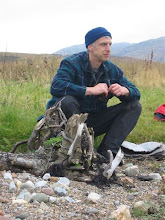







The recent cold nights and shorter days are having their annual impact. The Moss is changing colour. Actually the Moss is changing colour on a daily basis, it isn't just green in summer and brown in winter, the greens of June are very different from the greens of August and the browns of November are very different from the browns of February. I am sure that if shown a photo taken at Flanders regular visitors could guess within a few weeks what month it was taken in. The cotton grass looking like its on fire, the birches are speckled yellow, brown and green and the heather is going that muted purple of gone over blossoms. With a bit of sun there are still plenty of insects to study from 5 minutes lying on the boardwalk. These changing hues are always best seen on wilder sites so the contrast between the Moss and the surrounding intensive farmland is even greater at this time of year. So why not go hue spotting ?
























